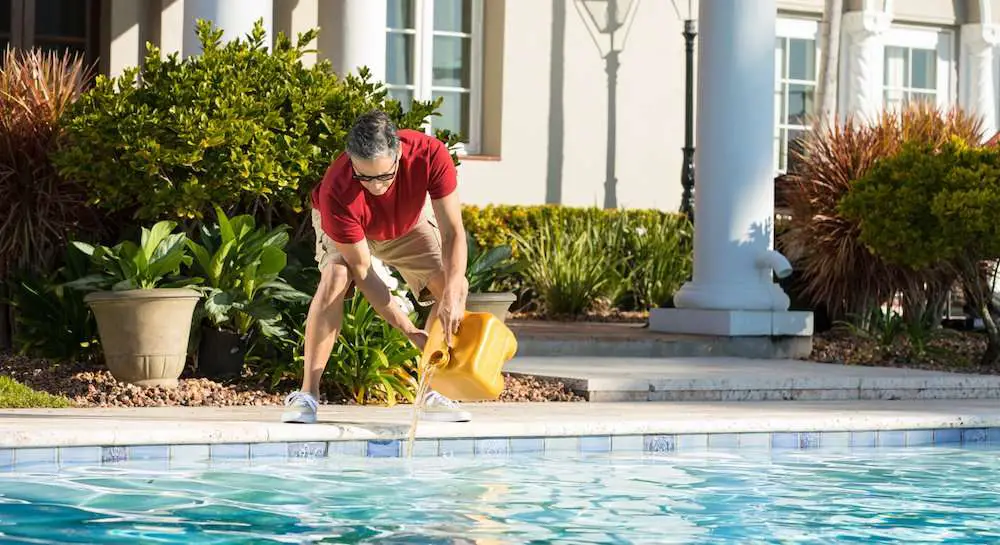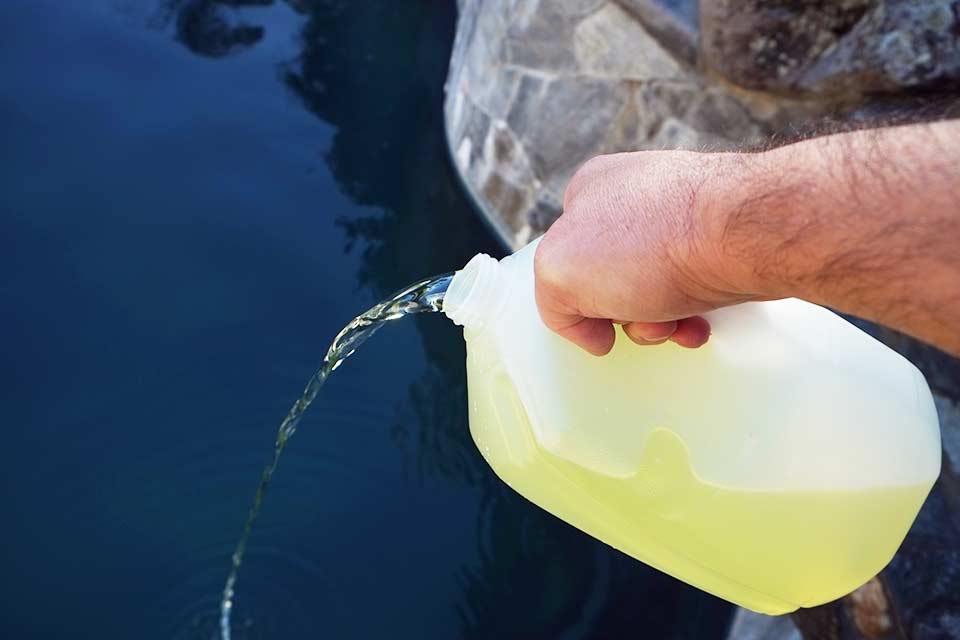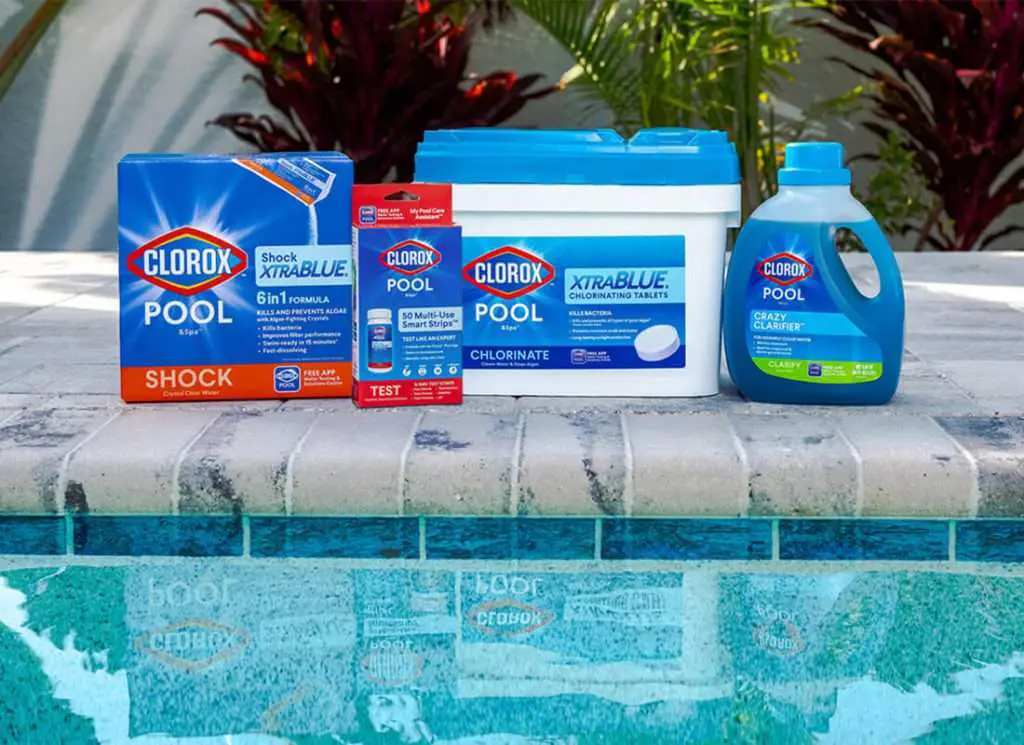What Is The Difference Between Pool Shocks
Well first, what is pool shock? Shock is a concentrated chemical formula used to increase available or free chlorine when your standard sanitizer gets behind in its duties. Sanitizers work to oxidize or break down organics and destroy bacteria. But they can become overwhelmed by higher levels of these compounds which rise after an increased bather load or heavy debris from inclement weather.
Organics come from many sources dead skin cells, sweat, sunscreen, dirt, and leaves, to name a few. These not only muck up your pool but also provide a veritable all-you-can-eat buffet for bacteria and can set the stage for an algae bloom. This is when pool shock comes in to save the day by giving a boost to your sanitizer. Here are the three main types of pool shock, which vary by their chemical composition.
Chlorine Shock Treatment When And Why
Fast chlorine is to be used in addition to a basic treatment with slow chlorine rollers.
It is advised to be used as a remedial treatment:
- In the spring, after the winterization of your pool. Accompanied by thorough manual cleaning and continuous filtration.
- When the water in your pool becomes cloudy and the disinfection capacity of your water is too low, do a shock treatment to quickly restore the situation.
- During hot weather, algae can grow in your pool, shock chlorination can solve this problem.
- After heavy use of the pool, to avoid any imbalance or bacteria growth.
- After outdoor pollution , a shock treatment can be considered in order to quickly restore the swimming water to its correct condition.
Pool Chlorine Vs Shock: Whats The Difference
- |December 5, 2020
Learning about all the disinfecting chemicals that go into pool water, and the balancing of them, can be confusing.
When it comes time to understand the difference between pool chlorine vs shock, they might seem like the same thing.
But are they?
Yes, and no. We lay it all out for you in this article.
What Is Pool Chlorine?
Pool chlorine is a sanitizer and oxidizer that keeps your pool water free from germs, bacteria, viruses, and organic pollutants.
Breaking it down, chlorine releases two chemicals into the water: hypochlorous acid and hypochlorite ion . They attack the enzymes and structures inside the cells of pollutants, destroying them.
The result is water thats clean and safe to swim in.
When talking about chlorine and how it relates to swimming pools, theres three terms that are used to describe the different states.
Free available chlorine , often shortened to free chlorine or available chlorine. Its what most people think of when chlorine is mentioned, because its chlorine in its purest state unused and ready to sanitize your pool water.
Combined chlorine , often referred to as chloramine, is chlorine that has been used up in your pool after attacking pollutants, making it ineffective at keeping your pool water sanitized.
Are There Different Types of Chlorine?
Chlorine comes in 2 categories: unstabilized and stabilized.
Unstabilized chlorine comes in 3 types: sodium hypochlorite , lithium hypochlorite, and calcium hypochlorite.
Read Also: Can Lice Live In Chlorine Pools
What Is Difference Between Shock And Chlorine
difference between chlorineshockShockchlorineshockchlorineChlorinechlorinein theshock
. Herein, is chlorine and shock the same thing?
Liquid chlorine and granular shock havethe same active chemical that sanitizes your pool, whatchanges is the strength and the way you use it. A quick disclaimer:The word chlorine is often usedinappropriately, but has become the generic term for the world’smost common sanitizer.
Likewise, how much chlorine do you need to shock a pool? A chlorine level of between 10 ppm and 30 ppm,sustained for several hours, is usually needed to remove algae,bacteria and chloramines. Super Shock can deliver 10 ppm per10,000 gals, per 1 lb. bag, in good water conditions youmay need more.
Correspondingly, what does Shocking a pool mean?
Pool Shocking 101. The term,”Shocking refers to the process of adding chlorine ornon-chlorine chemicals to your pool in order to raise the”free chlorine level to a point where contaminates such asalgae, combined chlorine and bacteriaare destroyed.
How long do you have to wait after you shock the pool?
It is recommended to wait at least 20 minutes to an hourafter adding water balancing chemicals. You should wait 2-4hours to swim from themoment you use calcium chloride in your pool. It is safe toswim once your chlorine levels are around 5 ppm or after 24hours.
What Is The Best Time Of Day To Shock A Swimming Pool

Shock your pool late in the evening or at night, when the sun is down, to make sure free chlorine will stay in your water longer. Ultraviolet rays from direct sunlight greatly reduces free chlorine levels, so shocking during the day will not be very effective.
If you absolutely must do it during daytime, use a chlorine stabilizer, such as cyanuric acid, to prolong the life the chlorine.
You May Like: How Do You Get Iron Out Of Pool Water
Chlorinated Shock Vs Non
Normally, your pool is kept clean by chlorine from chlorine tabs, a salt chlorinator, a cartridge system, or some other slow-release, low-dose system. But when the chlorine in your pool is not doing the trick, you may need to shock your pool. But when it comes to shocking your pool, there are choices. Many pool owners are left wondering what the best way is to shock their pools. In this article, we will compare chlorinated shock vs. non-chlorine shock for swimming pools.
What About For My Hot Tub Do I Need To Shock That Too
Congratulations, youre one of the fortunate among us with a hot tub. But calcium hypochlorite is not for you. This is because its unstabilized, meaning that it breaks down in heat like direct sunlightand loses 95% of its effectiveness in a hot tub. But dont think youre in the clear: no matter what sanitizer you use, you still have to worry about chlorines .
To shock your hot tub, youll want to use a stabilized shock like dichlor shock, which is also inexpensive and widely available. That is, unless you use two specific sanitizers: for a biguanide sanitizer, youre better opting in for a biguanide shock, and for a spa mineral sanitizer, youll want non-chlorine shock.
All cleaning chemicals only spread evenly thanks to your pool pump. For thorough circulation, try the 1.5 HP Variable Speed Blue Torrent Thunder Pool Pump. It pays itself off in energy saved and includes a lifetime warranty. As customer Eric D. says, For variable speeds, cant find much better price than this. Day one, I fired this pump up and it ran clean and fast.
You May Like: Inground Pool Syracuse Ny
Are Pool And Spa Chemicals The Same
- Hits: 38531
We get a lot of questions from people who wonder if they can use their pool chemicals to treat their hot tubs. To the untrained eye, all the different chemical options can seem very similar, so knowing which products are beneficial in certain scenarios can be very advantageous. Read on to learn the difference between pool and spa chemicals and the advantages of professional help from a qualityspa and pool store in St. Paul, MN.
Chlorine Shock Vs Non
Today we answer a quick question from a long time customer whats better, chlorine shock or the chlorine-free shock?.
I wish I could deliver the answer with the same succinct single sentence, but the answer has too many layers.
Both types of pool shock are oxidizers that will destroy organic matter in minutes, but only one is a true disinfectant, bactericide and herbicide.
So then I give you Pool Shock Cage Match of the Century! Chlorine Shock Vs. Non-Chlorine Shock. In this corner
Don’t Miss: Do It Yourself Fiberglass Pools
It Should Not Be Done Together
While shocking and adding algaecide is effective in getting rid of algae, it should not be done together. This is because when you mix chlorine and algaecide together, it renders both of them useless. Hence, you should first shock the pool and wait for the chlorine levels to fall below 5 PPM. Only then should you introduce algaecide to get the best results.
Can You Put Stabilizer Directly In Pool
There are two methods you can use to dissolve stabilizer into your pool water. You can either add the stabilizer to a pool skimmer box sock and hang the sock in front of the return jet or place it in the skimmer box. Or you can simply mix it in a bucket of water first and dump it into the skimmer box.
Recommended Reading: Spiders In Pool Skimmer
Types Of Granular Pool Shock
There are three main types of granular pool shock. The most common kind is Calcium Hypochlorite or Cal Hypo, which is the most economical and maintains the power of chlorine shocks needed to clean out a pool.
The other type of pool shock is Dichlor, or Sodium Dichloro-S-Triazinetrione. This fast-acting solution stains less than Cal Hypo but has a lower concentration of chlorine.
The third kind of granular shock is chlorine-free. Called Potassium Monopersulfate, this is a chemical used when you don’t want or need chlorine to shock the pool entirely. While it lacks chlorine’s power, it doesn’t impact the water’s pH and alkaline levels as much and can make the water safe for swimming in under 15 minutes.
Can I Just Drop Pool Shock Right In

As long as you have shock that doesnt require pre-dissolving, adding pool shock to your pool is unbelievably easy. All you have to do is walk slowly around the perimeter of your pool and pour it straight in.
If you have a type of sodium hypochlorite that requires pre-dissolving, add each pound to a five pound bucket of water and give it a mix and some time before adding it to your pool.
In either case, if you have an outdoor pool remember to apply pool shock at dusk or at night, or the sun will burn out the compound that makes it effective. True to its name, pool shock for pools is usually unstabilized. If youre adding pool shock to your hot tub, any time will do.
Unless youre using a non-chlorine shock, youll want to wait eight hours after using shock before you jump back into the pool. If youre a night swimmer, go you. Just add pool shock in after youre done for the day.
Shocking your above-ground pool? Make sure its circulated properly with a high-powered pump like the Copper Force Above Ground Pool Pump, which has three options for horsepower and an ultra-cool operation. According to customer Doug Paar, The pump is very quiet and has good pressure. I would recommend.
Don’t Miss: How Do I Lower The Alkalinity In My Pool
The 11 Best Pool Shock For Crystal Clear Water
Owning a swimming pool requires you to take care of a wide range of maintenance and upkeep if you want to keep it at its best.
If youre new to pools, you may not have encountered a pool shock before, so what is this stuff and why should you care?
Well, shocking your pool normally involved delivering a high dose of chlorine that serves to kill bacteria and algae, while at the same time clarifying the water in your pool. Pool shock ensures that your water looks great and stays safe and clear, too.
The process of shocking increases normal chlorine levels by up to 5 times, fully sanitizing the water in the process. During the process, pool shock also oxidizes combined chlorine molecules, which leads to a boost in the free chlorine levels. Free chlorine is good chlorine, in that it will target algae and bacteria.
Given the fact you may never have seen pool shock before, its understandable if you have no clue what youre looking for when youre comparing the best pool shock treatments. Focus on the following points to make your life easier on the buying trail.
OK, with those basics in place, you should be confident of navigating the best pool shocks on the market and finding the right one for your needs.
Well launch in now with our pool shock reviews so you can assess the state of the market.
Wildrivercountry.com is reader-supported. When you buy via the links on our site, we may earn an affiliate commission at no cost to you.
How Often Should I Shock My Pool
How often you should shock your pool depends on how often the pool is used and how much exposure your pool is getting to sunlight. For general maintenance and upkeep, everyday to weekly shocking is ideal depending on the reading of free chlorine that should always be 3 ppm.
If you have lots of people swimming on a daily basis, you should test free chlorine and shock as required every single day and at least weekly when the pool is not very busy.
Don’t Miss: Why Is Pool Chlorine So Expensive
What Is Granular Pool Shock And How Does It Differ From Liquid Chlorine
When purchasing pool maintenance supplies, you will inevitably come across different forms of chlorine for your pool.
Though chlorine is actually a gas, it has become a generic term for the hypochlorous acid that sanitizes pools, used in a process called “shocking.” It is one of the safest and most cost-effective ways to sanitize a confined body of water and eliminate bacteria, algae, germs, and viruses.
There are a few notable differences between granular pool shocks and liquid chlorine, which you have to know before deciding which will work better for your pool.
Shocking Your Pool Faq
When is it time to shock your pool?
- Every couple of weeks during the swimming season.
- When your pool is outside of the recommended free chlorine levels of 1-3 ppm. Shocking your pool will raise the chlorine level.
What about a salt pool?
Yes, even salt pools need a little help once in a while. Salt water pools utilize a chlorine generator to convert salt into chlorine. You can adjust the generator to increase the level of chlorine produced to counteract higher chlorine demands caused by contaminants. However, even salt water pools need to be shocked when the generator cannot keep up with a heavy load of contamination.
When should you shock your pool?
Regular pool maintenance is essential for healthy, efficient, and economical pool operation. For best results, experts recommend shocking your pool when these circumstances occur:
How do I shock my pool?
Shocking your pool is a fairly simple process. Before you begin, uncover your pool, skim the pool, vacuum the sediment, and brush the walls, floor and coves. Before adding shock, youll want to protect yourself with the appropriate gear which includes protective goggles, gloves, and work clothes.
When water tests okay, you are ready to go dive right in!
You May Like: What Is Soda Ash Used For In Swimming Pools
The Pool Shocking Process
Remember, chlorinated pool shock must be done at or after dusk and you must wait at least 8 hours before safely using your pool again.
If you have any questions or issues shocking your pool, feel free to stop by our storefront and let us help you out.
Key Differences Between Chlorine & Powdered Shock
There are a few key differences between liquid chlorine and powdered shock. Liquid chlorine is generally less costly than granular shock and comes in refillable containers, where granular shock does not. Liquid chlorine does not need to dissolve in your water as it is already in liquid form. In addition, liquid chlorine is non-scaling and leaves no residue. Watch out for your clothes though, as liquid chlorine can easily stain them.
Some powdered shock products can be poured directly into your pool but most of them have to be mixed with water to prevent staining. If there are any powdered shock grains left at the bottom of your pool after a treatment, be sure to vacuum them out as soon as possible.
You May Like: Can Vdara Use Aria Pool
How Often To Shock Your Pool
You dont want to wait for a bad smell or itchy eyes to happen before you shock your pool. We recommend shocking your pool once a week, or at least once every other week to properly maintain your water chemistry. The more often you use the pool, the more often you should reach for the swimming pool shock.
In addition to your weekly or semi-weekly treatments, you may want to perform an extra pool shock under certain circumstances, such as after:
- heavy pool use
- a severe rainstorm or damaging winds
- a major water level change
- a bowel-related pool accident
Think of extra shocks as insurance against wayward algae and other contaminants. Its better to take out any bacteria before it has a chance to affect the quality of your water or make anyone sick.
Main Differences Between Shock And Chlorine

You May Like: How To Hide Pool Equipment
